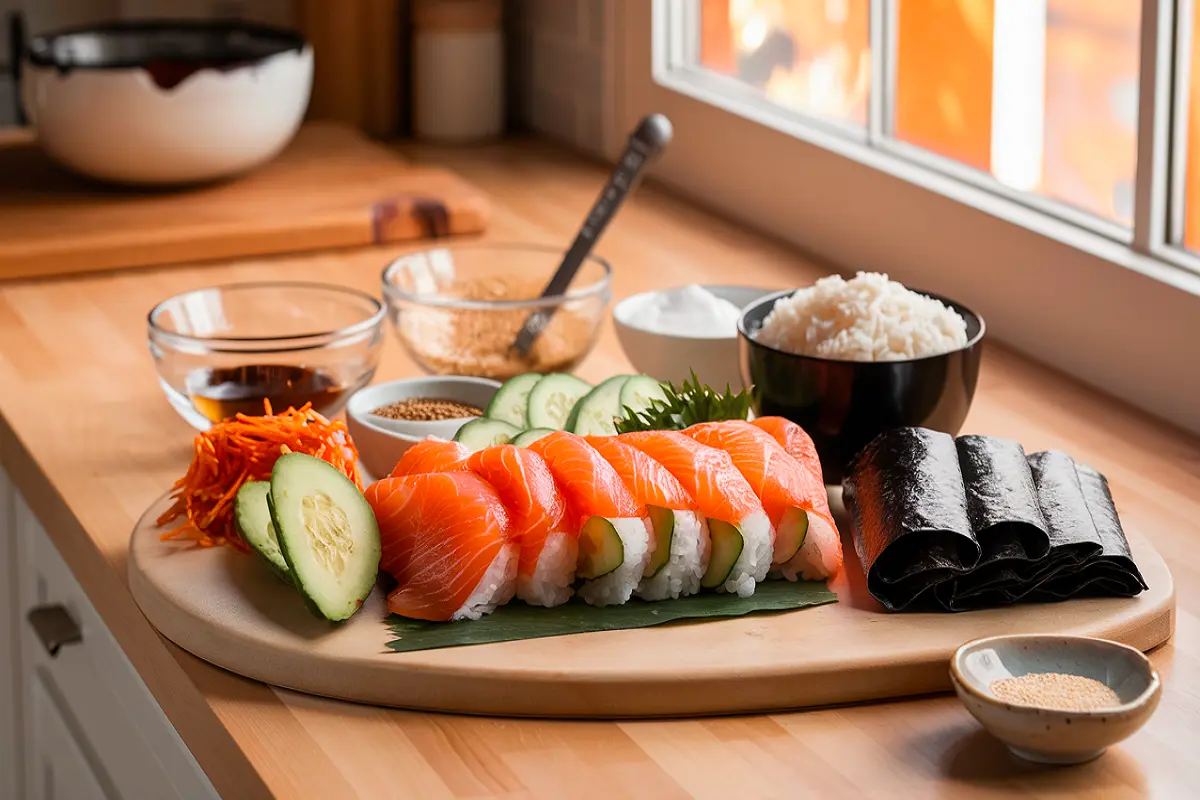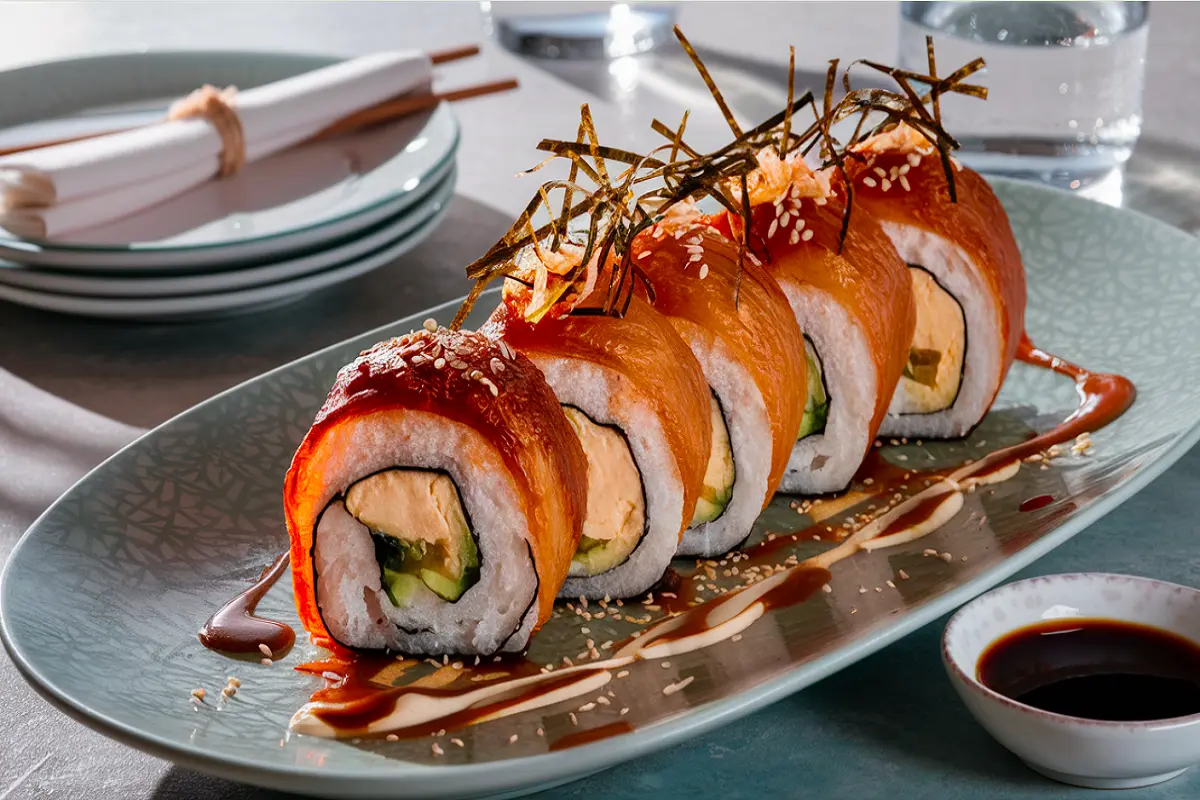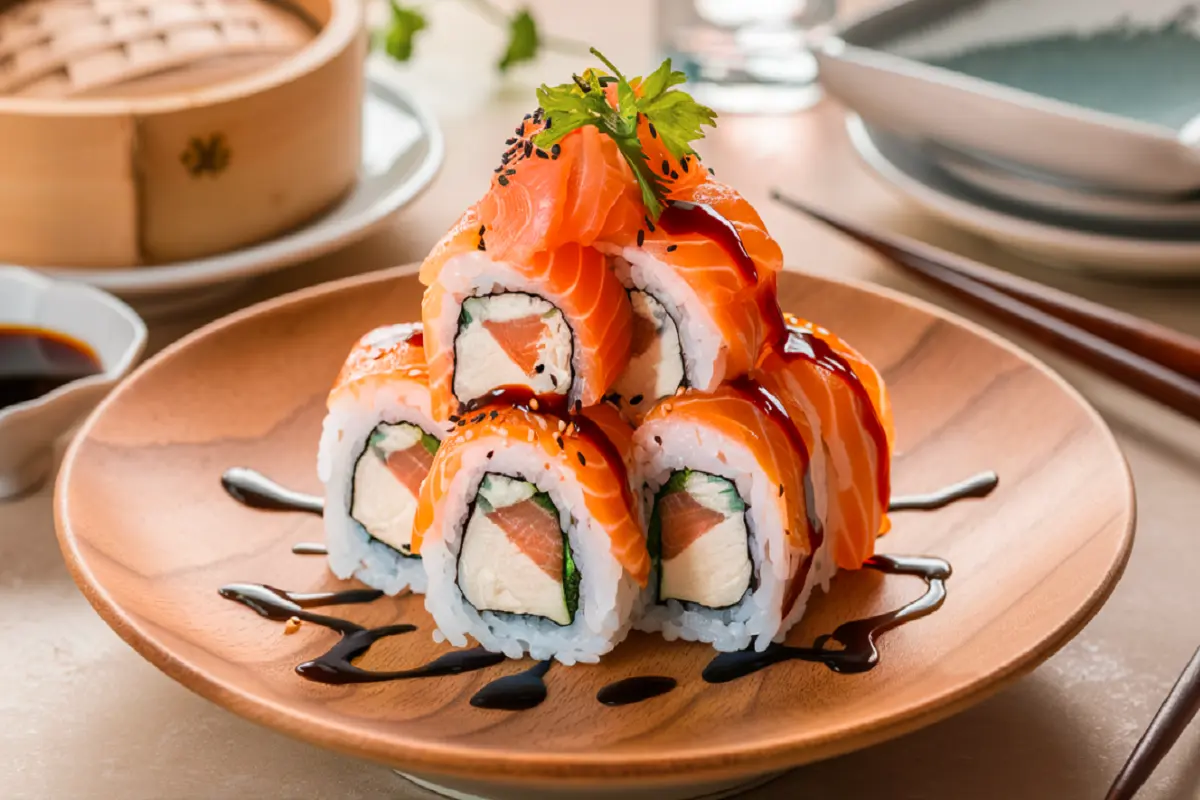The Alaska Roll is a flavorful sushi roll that combines fresh salmon, creamy avocado, cucumber, and sushi rice wrapped in nori (seaweed). This inside-out roll often features thinly sliced salmon placed on top of the roll, and it is sometimes served with a drizzle of spicy mayo or other sauces. With its simplicity and balance of flavors, the Alaska Roll is a popular sushi option that can be made at home. In this comprehensive recipe, we will guide you through the ingredients, step-by-step preparation, tips for achieving the best results, and provide answers to frequently asked questions. You’ll also find pairing suggestions to complete your sushi meal.
Introduction
Sushi is known for its delicate balance of flavors, and the Alaska Roll is no exception. This sushi roll features sushi-grade salmon, avocado, and cucumber, wrapped in seasoned sushi rice and nori. The combination of textures—from the creamy avocado to the crunch of cucumber—makes the Alaska Roll a crowd-pleaser. If you’ve ever wondered how to make sushi at home, this Alaska Roll recipe is a great place to start. With its simple ingredients and easy technique, you’ll be rolling sushi like a pro in no time.
Ingredients for Alaska Roll

Here’s a breakdown of the key ingredients for making Alaska Roll and their role in the recipe:
1. Sushi-Grade Salmon
Salmon is the star ingredient of the Alaska Roll. It should be sushi-grade, meaning it has been frozen and stored at a temperature that kills parasites, making it safe to eat raw. The salmon is used both inside and on top of the roll, adding a rich flavor and smooth texture.
Substitutions: If you don’t have access to sushi-grade salmon, you can use smoked salmon for a different twist. Cooked shrimp or crab can also be used as alternatives.
2. Avocado
Avocado adds creaminess to the Alaska Roll, balancing the richness of the salmon with its buttery texture. The ripe avocado slices are placed inside the roll, providing a smooth contrast to the other ingredients.
Substitutions: If avocado is unavailable, you can use cream cheese for a similar creamy effect.
3. Cucumber
Cucumber provides a refreshing crunch that complements the creamy and rich components of the roll. It is thinly sliced and placed inside the roll alongside the avocado and salmon.
Substitutions: If you don’t have cucumber, you can use julienned carrots, bell peppers, or even thin slices of zucchini.
4. Sushi Rice
Sushi rice is the foundation of the roll. It’s prepared by cooking short-grain rice and seasoning it with a mixture of rice vinegar, sugar, and salt. The rice should be sticky enough to hold the roll together but not mushy.
Substitutions: While sushi rice is ideal, you can use short-grain brown rice for a healthier version. Just note that it won’t be as sticky as traditional sushi rice.
5. Nori (Seaweed Sheets)
Nori is the edible seaweed used to wrap the roll. It provides a subtle umami flavor and helps hold the sushi together.
Substitutions: If you want to avoid seaweed, you can make the roll without it, but the structure may not hold as well. Soy paper is another alternative.
6. Spicy Mayo (Optional)
Spicy mayo is often drizzled on top of the roll for added flavor. It’s typically made with mayonnaise and sriracha.
Substitutions: You can use plain mayonnaise, eel sauce, or teriyaki sauce for different flavor profiles.
7. Sesame Seeds (Optional)
Sesame seeds are sometimes sprinkled on top of the roll for an extra layer of texture and flavor.
Substitutions: Panko breadcrumbs can be used for a crunchy topping instead of sesame seeds.
Step-by-Step Guide to Preparing Alaska Roll
Making sushi at home may seem daunting, but with a little practice, you can master the Alaska Roll. Follow these step-by-step instructions to prepare a delicious roll that rivals your favorite sushi restaurant.
Step 1: Prepare the Sushi Rice
Start by rinsing the sushi rice under cold water until the water runs clear. Cook the rice according to the package instructions. Once cooked, let it cool slightly before adding the rice vinegar, sugar, and salt. Mix gently to combine and set aside to cool completely.
Step 2: Prepare the Fillings
While the rice is cooling, prepare the fillings. Slice the sushi-grade salmon into thin strips. Peel and pit the avocado, then slice it into thin pieces. Julienne the cucumber into thin strips.
Step 3: Set Up Your Rolling Station
Place a bamboo sushi mat on a flat surface and cover it with plastic wrap to prevent sticking. Lay a sheet of nori on top, shiny side down.
Step 4: Assemble the Roll
Wet your hands with water to prevent the rice from sticking. Take a handful of sushi rice and spread it evenly over the nori, leaving a 1-inch border at the top. Flip the nori over so the rice is now on the bottom. Place a few strips of salmon, avocado, and cucumber across the center of the nori.
Step 5: Roll the Sushi
Using the bamboo mat, carefully lift the edge of the nori and begin rolling it over the fillings, applying gentle pressure to form a tight roll. Continue rolling until the nori and rice completely enclose the fillings.
Step 6: Add the Topping
Place thin slices of salmon on top of the roll, using the bamboo mat to gently press the salmon into the rice. This will help the salmon adhere to the roll.
Step 7: Slice the Roll
With a sharp knife, slice the roll into even pieces. Wet the knife between cuts to ensure a clean slice without tearing the roll.
Step 8: Garnish and Serve
Drizzle spicy mayo or other sauces over the roll and sprinkle with sesame seeds, if desired. Serve with soy sauce, wasabi, and pickled ginger.
Tips for Achieving the Best Alaska Roll

Achieving the perfect Alaska Roll takes practice, but here are some tips to help you along the way:
1. Use Sushi-Grade Fish
Always use sushi-grade salmon to ensure safety when consuming raw fish. If you’re unsure, ask your fishmonger if the salmon is safe for sushi.
2. Keep Your Hands Wet
Wet your hands with water or rice vinegar when handling the rice to prevent it from sticking to your fingers.
3. Use a Sharp Knife
A sharp knife is essential for slicing the roll cleanly. Be sure to wet the blade between cuts for the best results.
4. Don’t Overfill the Roll
It’s tempting to pack the roll with lots of fillings, but overfilling can make it difficult to roll and cut. Use just enough filling to achieve a balanced roll.
5. Practice Your Rolling Technique
Rolling sushi takes practice, so don’t get discouraged if your first few rolls aren’t perfect. Use the bamboo mat to apply even pressure as you roll, and keep practicing.
Pairing Suggestions for Alaska Roll
Sushi is typically served with a few classic accompaniments, but there are plenty of other dishes that can complement your Alaska Roll:
1. Soy Sauce, Wasabi, and Pickled Ginger
These traditional sushi accompaniments help balance the flavors of the roll and cleanse the palate between bites.
2. Miso Soup
A warm bowl of miso soup pairs perfectly with the fresh, cold flavors of the Alaska Roll.
3. Seaweed Salad
The umami-rich seaweed salad provides a light and refreshing contrast to the richness of the salmon and avocado.
4. Edamame
Steamed edamame with sea salt is a simple but satisfying side dish that complements sushi well.
5. Japanese Cucumber Salad
A tangy cucumber salad with rice vinegar, soy sauce, and sesame seeds adds a refreshing crunch to your sushi meal.
Frequently Asked Questions (FAQs) About Alaska Roll
1. What is an Alaska Roll?
An Alaska Roll is a type of sushi roll made with sushi-grade salmon, avocado, and cucumber, wrapped in nori and sushi rice, often topped with more salmon and drizzled with sauces.
2. Can I Use Cooked Salmon Instead of Raw in Alaska Roll?
Yes, you can use cooked or smoked salmon as a substitute for raw salmon if you prefer.
3. How Do I Store Leftover Alaska Roll?
Sushi is best eaten fresh, but you can store leftover Alaska Rolls in an airtight container in the fridge for up to 24 hours. Keep in mind that the texture of the rice and fillings may change slightly.
4. Can I Freeze Alaska Rolls?
Freezing sushi is not recommended, as the texture of the rice and fish will be compromised once thawed.
5. Can I Make Alaska Rolls Ahead of Time?
While sushi is best made fresh, you can prepare the fillings and rice ahead of time and assemble the rolls just before serving.
Conclusion
The Alaska Roll is a delicious and versatile sushi roll that brings together fresh salmon, creamy avocado, and crisp cucumber, all wrapped in seasoned rice and nori. Making sushi at home may seem intimidating, but with this step-by-step guide and a bit of practice, you’ll be able to create this crowd-pleasing dish with ease. Whether served as an appetizer, a main course, or as part of a sushi platter,- the Alaska Roll brings a balance of freshness, creaminess, and crunch to any meal. With a bit of practice, anyone can master the art of making this delicious sushi roll at home. Whether served as part of a sushi platter, with sides like miso soup or cucumber salad, or enjoyed on its own, the Alaska Roll is a versatile dish that’s perfect for sushi lovers everywhere. With these tips, you’ll be able to create restaurant-quality sushi in your own kitchen.

